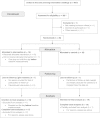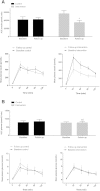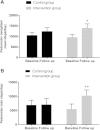A randomized controlled trial on a multicomponent intervention for overweight school-aged children - Copenhagen, Denmark
- PMID: 25330848
- PMCID: PMC4287468
- DOI: 10.1186/1471-2431-14-273
A randomized controlled trial on a multicomponent intervention for overweight school-aged children - Copenhagen, Denmark
Abstract
Background: Obesity amongst children is a growing problem worldwide. In contrast to adults, little is known on the effects of controlled weight loss on components of the metabolic syndrome in children. The primary aim of the study was to evaluate the effects of a 20-week exercise and diet guidance intervention on body mass index (BMI) in a group of overweight children. Our hypothesis was an observed reduction in BMI and secondarily in body fat content, insulin insensitivity, and other components of the metabolic syndrome in the intervention group.
Methods: School children from Copenhagen were randomly allocated to an intervention group (n = 19) or a control group (n = 19). Anthropometric assessment, whole body dual-energy X-ray absorptiometry scan, two hours oral glucose tolerance test, steps measured by pedometer, and fitness tests were measured at baseline and at 20 weeks.
Results: Thirty-seven children (30 girls) participated at baseline, aged 8.7 ± 0.9 years with a BMI of 21.8 ± 3.7 kg/m2 (mean ± SD), and 36 children completed the study. The intervention group decreased their BMI (the intervention effect is the difference in change between the groups adjusted for the respective baseline values (DELTA) = -2.0 kg/m2, 95% CI: -2.5; -1.5, P <0.001), total body mass (DELTA = -4.0 kg, 95% CI: -4.9; -3.0, P <0.001), and fat mass (DELTA = -3.3 kg, 95% CI: -4.2; -2.7, P <0.001) compared to the control group after the intervention. The intervention group displayed decreased waist, hip and waist-to-height ratio (WHtR) (all three variables; P <0.001), area under curve for plasma insulin (P <0.05), and increased mean and minimum steps/day (P <0.05 and P <0.01, respectively).
Conclusions: The multicomponent intervention had significant favorable effects on BMI, weight, WHtR, mean and minimum steps/day, and fat mass. In addition, similar beneficial metabolic effects were found in the children as shown in adults, e.g. increase in peripheral insulin sensitivity.
Trial registration: Clinicaltrials.gov Identifier number NCT01660789.
Figures



References
-
- WORLD HEALTH ORGANIZATION . Prioritizing areas for action in the field of population-based prevention of CHILDHOOD OBESITY. 2012.
-
- Juhola J, Magnussen CG, Viikari JS, Kahonen M, Hutri-Kahonen N, Jula A, Lehtimaki T, Akerblom HK, Pietikainen M, Laitinen T, Jokinen E, Taittonen L, Raitakari OT, Juonala M. Tracking of serum lipid levels, blood pressure, and body mass index from childhood to adulthood: the Cardiovascular Risk in Young Finns Study. J Pediatr. 2011;159:584–590. doi: 10.1016/j.jpeds.2011.03.021. - DOI - PubMed
Pre-publication history
-
- The pre-publication history for this paper can be accessed here:http://www.biomedcentral.com/1471-2431/14/273/prepub
Publication types
MeSH terms
Substances
Associated data
LinkOut - more resources
Full Text Sources
Other Literature Sources
Medical

